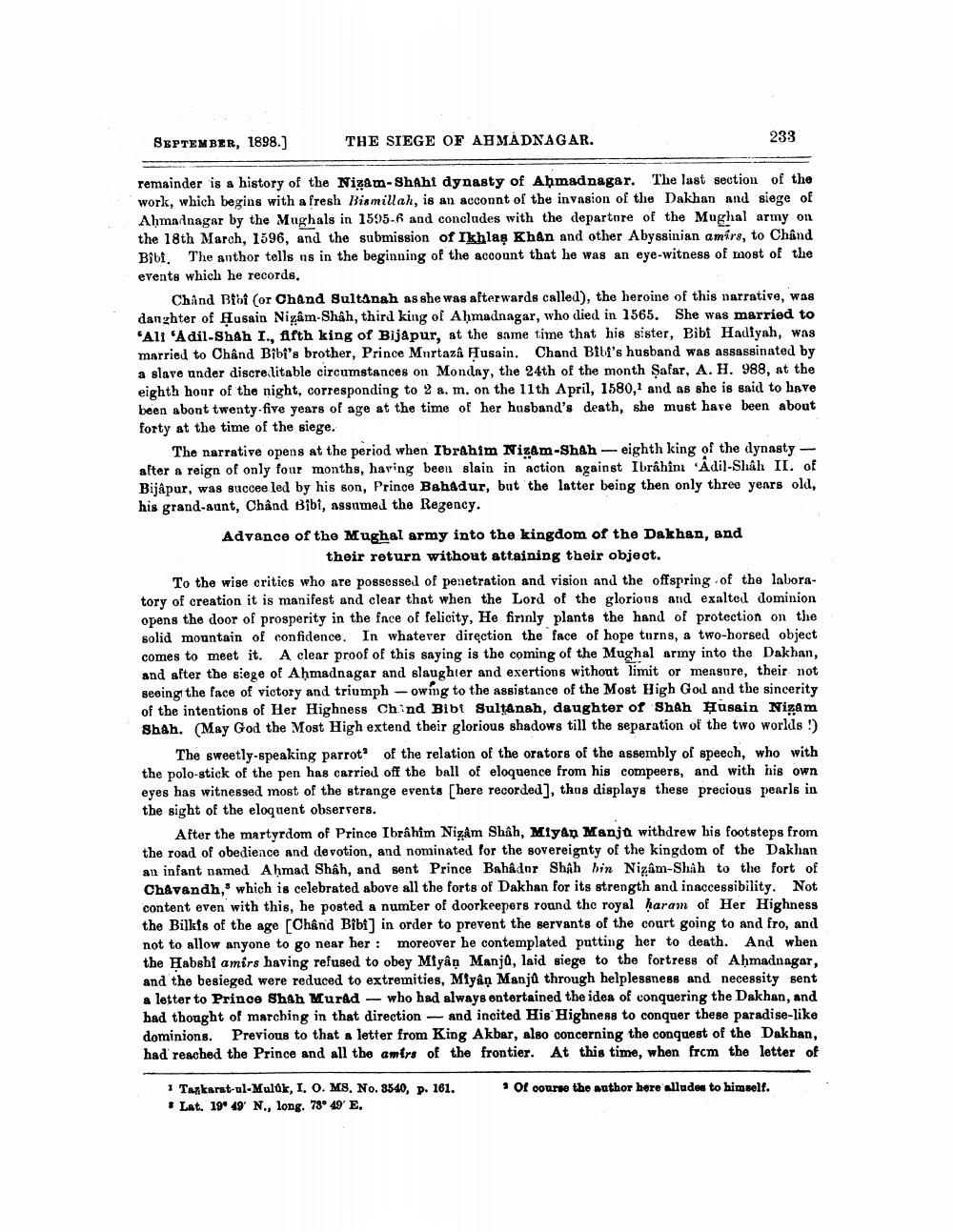________________
SEPTEMBER, 1898.)
THE SIEGE OF AHMADNAGAR.
233
remainder is a history of the Nizam-Shahi dynasty of Aḥmadnagar. The last section of the work, which begins with a fresh Bismillah, is an account of the invasion of the Dakhan and siege of Ahmadnagar by the Mughals in 1595.h and concludes with the departure of the Mughal army on the 18th March, 1596, and the submission of Ikhlaş Khan and other Abyssinian amirs, to Chand Bibi. The anthor tells us in the beginning of the account that he was an eye-witness of most of the events which he records.
Chand Bibi (or Chand Sultanah as she was afterwards called), the heroine of this narrative, was danghter of Husain Nizâm-Shah, third king of Ahmadnagar, who died in 1565. She was married to 'All Adil Shah I., Arth king of Bijapur, at the same time that his sister, Bibi Hadiyah, was married to Chand Bibi's brother, Prince Mirtaza Husain. Chand Bibi's husband was assassinated by a slave under discre litable circumstances on Monday, the 24th of the month Şafar, A. H. 988, at the eighth hour of the night, corresponding to 2 a. m. on the 11th April, 1580, and as she is said to have been abont twenty five years of age at the time of her husband's death, she must have been about forty at the time of the siege.
The narrative opens at the period when Ibrahim Nizâm-Shah - eighth king of the dynasty - after a reign of only four months, having been slain in action against Ibrahim Adil-Shah II. of Bijâpur, was succee led by his son, Prince Bahadur, but the latter being then only three years old, his grand-aant, Chand Bîbi, assumed the Regency. Advance of the Mughal army into the kingdom of the Dakhan, and
their return without attaining their object. To the wise critics who are possessed of penetration and vision and the offspring of the laboratory of creation it is manifest and clear that when the Lord of the glorious and exalteil dominion opens the door of prosperity in the face of felicity, He finnly plants the hand of protection on the solid mountain of confidence. In whatever direction the face of hope turns, a two-horsed object comes to meet it. A clear proof of this saying is the coming of the Mughal army into the Dakhan, and after the siege of Ahmadnagar and slaughter and exertions without limit or mensure, their not seeing the face of victory and triumph - owing to the assistance of the Most High God and the sincerity of the intentions of Her Highness Chind Bibt Sultanah, daughter of Shah usain Nizam Shah. (May God the Most High extend their glorious shadows till the separation of the two worlds!)
The sweetly-speaking parrot' of the relation of the orators of the assembly of speech, who with the polo-stick of the pen has carried off the ball of eloquence from his compeers, and with his own eyes has witnessed most of the strange events [here recorded], thus displays these precious pearls in the sight of the eloquent observers.
After the martyrdom of Prince Ibrahim Nizam Shah, Miyan Manja withdrew his footsteps from the road of obedience and devotion, and nominated for the sovereignty of the kingdom of the Dakhan an infant named Ahmad Shah, and sent Prince Bahador Shah bin Nizâm-Shîh to the fort of Chåvandh," which is celebrated above all the forts of Dakhan for its strength and inaccessibility. Not content even with this, he posted a number of doorkeepers round the royal haram of Her Highness the Bilkis of the age [Chênd Bibi) in order to prevent the servants of the court going to and fro, and not to allow anyone to go near her: moreover he contemplated putting her to death. And when the Habshi amirs having refused to obey Miyân Manja, laid siege to the fortress of Ahmadnagar, and the besieged were reduced to extremities, Miyan Manja through helplessness and necessity sent a letter to Prince Shah Murad - who had always entertained the idea of conquering the Dakhan, and had thought of marching in that direction - and incited His Highness to conquer these paradise-like dominions. Previous to that letter from King Akbar, also concerning the conquest of the Dakban, had reached the Prince and all the amfrs of the frontier. At this time, when from the letter of
. Of course the author here alluden to himself.
1 Tarkarat-ul-Muldk, I. O. MS. No. 3540, p. 161. * Lat. 19° 49' N., long. 78° 49 E.




